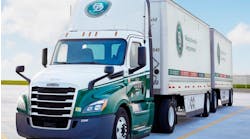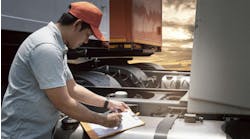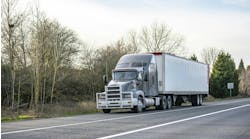There's a lot to like and a lot to dislike about both EGR and SCR technologies,” says Dr. Stephen Ciatti, principal mechanical engineer for Argonne National Laboratory (www.anl.gov), “but they are proven approaches to emissions reduction, and most manufacturers in the U.S. have already done most of the work to implement one solution or the other to meet 2010 requirements.”
According to Ciatti, there are two basic ways to reduce oxides of nitrogen (NOx) in diesel exhaust: “either do something to get rid of as much NOx as you can after it is produced by the engine, or don't produce it in the first place.” The first option is the selective catalytic reduction (SCR) aftertreatment approach; the second is EGR or enhanced exhaust gas recirculation.
“Basically, NOx formation is a function of the high combustion temperature in diesel engines,” he explains. “The hotter the combustion temperature, exponentially more NOx is created from disassociated oxygen and nitrogen molecules binding together. So if you want to reduce the NOx that is formed during combustion, you need to lower the peak combustion temperature by reducing the amount of oxygen molecules available. ”
TRADE-OFFS
“That is what EGR does,” Ciatti says. “It deprives the combustion event of some of its oxygen by introducing cooled exhaust gas, which is lower in oxygen, into the intake system, thereby reducing the combustion temperature and lowering NOx production.
“The good news is that you don't have to add much extra to the system to accomplish NOx reduction this way,” he adds. “The downside is that the lower-temperature diesel combustion is less efficient, so it creates more particulate matter and it burns more fuel. That is essentially what we did in 2007. We traded lower NOx for less fuel efficiency and more soot.” (That extra soot, also known as particulate matter or PM, did not result in more tailpipe emissions, however. All engines from 2007 on have diesel particulate filters [DPFs] as part of their exhaust system.)
SCR, like EGR, also involves trade-offs, according to Ciatti. “NOx is very hard to get rid of once it is formed,” he says. “It doesn't like to break apart. One way to get it to do that is to introduce something that will compete with the nitrogen for those oxygen molecules. The urea, or (NH2)2CO, injected into the exhaust stream during the SCR process does exactly that. In the presence of a catalyst, it turns into ammonia and carbon dioxide, which then reacts with the NOx to create nitrogen and water vapor, or 2N2 + 3H2O.
“The good thing about choosing SCR for 2010 compliance is that it permits the engine to operate at more optimal combustion temperatures to provide better power and fuel efficiency and lower soot generation,” he adds. “You do, however, have to purchase urea and carry it in a tank onboard the truck. And you have to use it.”
THE COMPLIANCE QUESTION
It is the “have to use it” issue that is the EPA's chief concern when it comes to SCR as a 2010 compliance solution (www.epa.gov). “Engine makers and OEMs using EGR and SCR will both demonstrate compliance with the 2010 standard in the same way — they must both run certain required emissions tests and submit the data gathered for certification,” says Byron Bunker, center director for the EPA Heavy-Duty On-Highway Center. “What is special about SCR is the required urea. We want to make sure that the certifiers are doing all they can to assure that end users of the SCR system will do what they should do to keep it operating properly.
“There are lots of things manufacturers can do to make a big difference,” he continues. “They can do more than anyone else to make sure that urea is readily available, for instance, just like any other replacement fluids required for a vehicle, such as oil or coolant. They can also use sensors and other onboard systems to make sure the driver knows when the urea tank needs to be refilled and that the system is durable and not easy to disable.”
In March 2007, the EPA issued guidance on the emissions certification procedures the agency wants to see for on-road diesel vehicles. Specifically, the agency outlined five elements it expects manufacturers to provide in order to have an SCR system certified as meeting 2010 requirements: an escalating driver warning system to alert the driver to the fact that the urea tank is approaching empty; a driver “inducement” (some means to ensure that the driver will not operate the vehicle without the reducing agent); a NOx or urea sensor or some other mechanism to prevent the use of an incorrect or diluted reducing agent; plus a durable and tamper-resistant design.
Since EGR systems require no action on the part of the vehicle operator and are much less prone to tampering or misuse, EPA concerns about compliance are correspondingly smaller, too. “Engine makers relying on EGR to meet 2010 NOx levels may be able to calculate NOx output rather than directly measuring NOx in the exhaust stream,” says Gary Parsons, global OEM and industry liaison manager for Chevron Oronite Co. LLC (www.chevron.com). “For instance, based on engine mapping, they may be able to use the angle of the EGR flow valve and known EGR flow rates as an indirect indicator of the NOx levels being produced and simply map the NOx levels created in the engine under various conditions.”
In other words, SCR systems will need some way of directly measuring NOx levels at the tailpipe, while EGR can assume tailpipe NOx emissions based on engine operating parameters.
When it comes to SCR and EGR, it is not strictly accurate to talk in terms of either/or, adds Parsons. “Practically speaking, SCR is not going to entirely replace EGR come 2010,” he says. “Even engine makers using SCR will probably have to use some level of EGR to reach the extremely low NOx levels required.”
WHAT NEXT?
Neither EGR nor SCR may be the end of the emissions reduction road. Although the EPA says it has no plans for regulations past 2010, there are other emissions reduction technologies and other approaches being explored today.
“Right now we have no plans for regulations past 2010,” says Bunker. “After all, we don't have far to go past 2010 to get to zero NOx emissions. That last little bit tends to be the most expensive to get so we have to weigh the cost to the benefit. Technologies will also continue to get better. We spend a lot of time ourselves investigating new technologies, especially combustion technologies.”
“Everybody is working on cleaner diesel combustion solutions,” agrees Parsons, “especially on what is called Homogeneous Charge Compression Ignition [HCCI] where air and fuel are premixed in the cylinder, more like a gasoline engine, but still ignited by compression as in a diesel engine.
“As a fuel, gasoline is very difficult to spontaneously ignite, which is why gasoline engines require a spark plug for ignition,” Parsons explains. “Octane is the term that is used to describe gasoline's ability to resist ignition. Diesel fuel, on the other hand, is less flammable than gasoline but much easier to ignite under the proper conditions, which is why diesel engines use compression rather than a spark plug for igniting the fuel.
“Cetane is the term used to describe diesel's ability to spontaneously ignite under pressure,” Parsons continues. “The goal with HCCI and partial HCCI is to create a better combustion technology plus a fuel with the right balance of octane and cetane, something that will ignite uniformly and at exactly the right moment for optimum, lower-temperature combustion, with enough heat to burn cleanly but at a low enough temperature to avoid producing NOx.”
HCCI is not the only alternative approach to emissions reduction that is being explored. So-called “NOx Absorbers” (or “Lean NOx Traps” or “Hydrocarbon-SCR Systems”) use hydrocarbons rather than ammonia to reduce NOx. They are already being used in some light-duty engines and have the advantage of not requiring an additional reductant like urea.
Today's Dodge Ram pick-up trucks equipped with Cummins engines, for instance, use Lean NOx Traps and are already able to meet 2010 emissions standards. However, NOx Traps currently rely on catalysts made with expensive precious metals to get the job done and have not yet been proven effective in heavy-duty applications.
Honda Motor Co. Ltd. has announced that it will introduce a diesel that meets 2010 standards via aftertreatment — and without the need for urea. Instead, Honda's system creates its own ammonia from diesel fuel and uses it to convert NOx into nitrogen and water during normal engine operation. Since diesel fuel is used in the NOx after-treatment system, however, there is a slight fuel economy penalty in these systems.
Canadian company NxtGen (www.nxtgen.com) says it is commercializing a system that can omit the need for SCR technology and also clean the diesel particulate filters introduced in 2007. The system makes use of a non-catalytic “synthesis gas” generator that converts diesel fuel, mixed with about 2% of the airflow from the exhaust manifold, into hydrogen and carbon monoxide. The resulting gaseous mixture can be pumped into the particulate filter and NOx absorber to regenerate them.
GAME CHANGES?
In addition to all the research being done on the combustion process itself, work continues on alternative fuels, hybrids, plug-in vehicles and other alternative power systems. One or more of these solutions could also dramatically change emissions requirements and technologies in the future.
“It were not best that we should all think alike; it is difference of opinion that makes horse-races.” Mark Twain wrote in his novel Pudd'nhead Wilson, back in 1894. This is particularly true in today's race for clean transportation solutions. Thanks to all those differences of opinion, there is a good chance that someone someday will win the race for clean, sustainable power with the perfect (or near-perfect) solution to the planet's energy needs. The good news in the meantime is that there are some proven technologies lining up at the gate for 2010.
SCR and EGR: Pros and cons
While EGR and SCR are both proven paths to reducing NOx emissions, there are trade-offs associated with each approach.
SCR advantages:
- Permits more optimized combustion
- Can enable better fuel efficiency/power
- No concerns about engine durability/oil degradation
- End product is nitrogen, water and carbon dioxide
- Urea not classified as hazardous to health
SCR trade-offs:
- System adds weight
- Adequate urea supply infrastructure not yet in place
- Purchasing urea is additional cost
- System, including sensors and other compliance-related devices, must be maintained
- Urea freezes at 12 deg. F., so may require heated storage
- Most effective at constant speeds and high loads; least in stop/start
- Urea (also in some fertilizers) is a water pollutant/harmful to fish
Cooled EGR advantages:
- Does not require additional onboard hardware
- Does not require the use of an additional fluid
- No loss of payload
- No impact on service intervals
- No driver intervention necessary for compliance
Cooled EGR trade-offs:
- Increases heat rejection, creating need for greater cooling capacity
- Decreases power density, fuel efficiency
- Potential engine durability and oil degradation issues
- Less combustion efficiency produces increased particulate matter, hydrocarbon, carbon monoxide
Sources: Chevron Oronite Co. LLC; Scania; VDI, Germany, “Market Overview of Exhaust Gas Treatment Solutions for Diesel Engines in Commercial Vehicles for Meeting Current and Upcoming Emission Legislation in the EU”; Volvo Trucks NA, “SCR: For EPA ‘10”; Environmental Protection Agency Heavy-Duty On-Highway Center, Argonne National Laboratory
The language of 2010 emissions control
AdBlue: A trademarked name under which urea is marketed for SCR systems in Europe.
Catalyst: A substance that modifies (especially increases the rate of) a chemical reaction, without being consumed in the process.
DEF (diesel emission fluid or diesel exhaust fluid): The emissions dosing fluid that is presently used in SCR systems in Europe (under the trademarked name, AdBlue) and elsewhere. It is comprised of 32.5% urea and 67.5% de-ionized water. Also see Urea.
DPF (diesel particulate filter): Filter located in the diesel exhaust stream to remove particulate matter (PM) from the exhaust. Required on engines starting in 2007 to meet vehicle emissions standards. Filters require the use of ultra-low sulfur diesel fuel to prevent excessive PM and premature plugging of the filter.
EGR (exhaust gas recirculation): The technology currently in use in the U.S. (and by some manufacturers in Europe) to comply with standards for reducing oxides of nitrogen (NOx) emissions from diesel engines. In an EGR engine, some of the exhaust gas is cooled and recycled back through the engine to dilute the amount of oxygen in the intake charge. This reduces the temperature of combustion and lowers the formation of NOx.
Euro emissions standards: Diesel emissions standards for EU (European Union) countries are based upon United Nations Economic Commission for Europe (UN ECU) standards, commonly called “Euro” standards.
HCCI (homogeneous charge compression ignition): A form of internal combustion in which air and fuel are premixed in the cylinder like a gasoline engine, but still ignited by compression as in a diesel engine to create lower combustion temperatures and produce less NOx.
Hydrocarbon-SCR: Also called Lean NOx Reduction. An aftertreatment system that uses hydrocarbons from diesel fuel or the exhaust stream instead of ammonia to reduce NOx.
Particulate matter: Solid particles of various sizes (some much smaller in diameter than a human hair) that are formed by incomplete fuel combustion and released as part of the engine's exhaust. Linked to various long- and short-term health problems, reductions in the particulate matter of exhaust gas were mandated by the 2007 EPA emissions standards and achieved using diesel particulate filters. Also see DPF and Soot.
SCR (selective catalytic reduction): A technique for reducing oxides of nitrogen (NOx) that involves injecting a fine mist of urea plus water (also called diesel emission fluid) through a catalyst into the engine's exhaust stream to create a chemical reaction to turn NOx into nitrogen and water vapor (plus carbon dioxide, which is released as the urea converts to ammonia during SCR).
Soot: Also called particulate matter or PM. The very fine carbon particles that are part of diesel particulate emissions. The “black” in engine exhaust emissions.
ULSD (ultra-low sulfur diesel fuel): Contains a maximum of 15 parts per million (ppm) sulfur. Reducing sulfur in fuel directly reduces particulate matter in the exhaust that is formed during combustion. Use of ULSD reduces particulate matter loading in the diesel particulate filter.
Urea: Carbonyl diamide (NH2)2CO. Turns into ammonia and carbon dioxide when heated during SCR — (NH2)2CO + H2O _ 2NH3 +CO2. Also see DEF and SCR.
Sources: Volvo Trucks NA; Chevron Oronite Co.; Diesel Progress; Other


